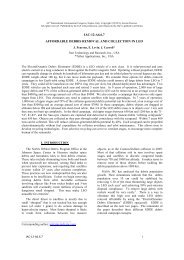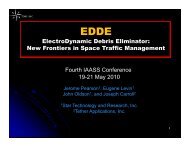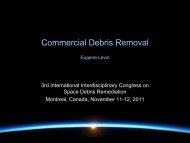The Cost of Future Collisions in LEO - Star Technology and Research
The Cost of Future Collisions in LEO - Star Technology and Research
The Cost of Future Collisions in LEO - Star Technology and Research
You also want an ePaper? Increase the reach of your titles
YUMPU automatically turns print PDFs into web optimized ePapers that Google loves.
26<br />
<strong>The</strong> conditional probability that the two objects will be with<strong>in</strong> “touch<strong>in</strong>g<br />
distance” <strong>in</strong> the direction <strong>of</strong> the <strong>in</strong>tersection l<strong>in</strong>e is obta<strong>in</strong>ed by <strong>in</strong>tegration<br />
P r ≈<br />
∫ H2<br />
H 1<br />
P A (h) P B (h) (D 1 + D 2 ) dh, (A3)<br />
where D 1 <strong>and</strong> D 2 are the typical dimensions <strong>of</strong> the objects, <strong>and</strong> (H 1 , H 2 ) is the<br />
range <strong>of</strong> overlapp<strong>in</strong>g altitudes.<br />
Fig. A2. Relative motion near the <strong>in</strong>tersection.<br />
<strong>The</strong> conditional probability that the two objects will be with<strong>in</strong> “touch<strong>in</strong>g<br />
distance” <strong>in</strong> projection onto a reference sphere near the <strong>in</strong>tersection l<strong>in</strong>e with given<br />
positions <strong>of</strong> the ascend<strong>in</strong>g nodes <strong>of</strong> the orbits is approximated as<br />
P ϑ ≈ D 1 + D 2<br />
2πR s<strong>in</strong> ϑ ,<br />
(A4)<br />
where R is the average orbit radius, <strong>and</strong> ϑ is the angle between the tangent to the<br />
trajectory <strong>of</strong> the object A <strong>and</strong> the velocity <strong>of</strong> the object B relative to the object A<br />
near the <strong>in</strong>tersection, as shown <strong>in</strong> Fig. A2. <strong>The</strong> reason<strong>in</strong>g is very simple. When the<br />
center <strong>of</strong> the object B passes the <strong>in</strong>tersection l<strong>in</strong>e, the distance between the center<br />
<strong>of</strong> the object A <strong>and</strong> the <strong>in</strong>tersection l<strong>in</strong>e measured along the orbit <strong>of</strong> the object A<br />
can be anywhere between 0 <strong>and</strong> approximately πR, but a collision can occur only<br />
when the distance is less than (D 1 + D 2 )/2 s<strong>in</strong> ϑ.<br />
If the objects ma<strong>in</strong>ta<strong>in</strong> certa<strong>in</strong> attitude, their dimensions <strong>in</strong> formulas (A1)<br />
<strong>and</strong> (A4) could have more specific mean<strong>in</strong>g. For example, if we consider two gravitationally<br />
stabilized cyl<strong>in</strong>ders, the dimensions <strong>in</strong> formula (A1) will represents their<br />
heights, while the dimensions <strong>in</strong> formula (A4) will represents their diameters.<br />
Averag<strong>in</strong>g over all possible nodal positions yields<br />
P ϑ ≈ D 1 + D 2<br />
2πR<br />
β, (A5)<br />
where β is the “<strong>in</strong>cl<strong>in</strong>ation pair<strong>in</strong>g” coefficient, as def<strong>in</strong>ed by Carroll [6],<br />
β = 1 ∫ 2π<br />
2π 0<br />
dφ<br />
s<strong>in</strong> ϑ ,<br />
(A6)








